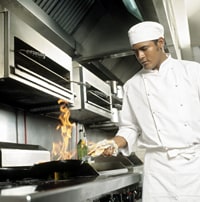Food Safety Practices of Restaurant Workers
EHS-Net Recommends
Restaurant managers and food-safety programs should work to improve food prep practices. Efforts should focus on
- Younger, less-experienced workers.
- Workers in independent restaurants.
Researchers should do more studies to find out what affects these food prep practices. This information could be used to find barriers to safe food prep. Fixing those barriers could help improve practices and reduce illness.

Why This Study Was Done
Studies show that foodborne illness is linked to eating outside the home (for example, in restaurants). They also show that food workers often do not handle food safely. It is important to learn more about how restaurant workers prepare food. This can help us find ways to improve how they prepare food.
What the Study Described
This study looked at four things restaurant workers do that affect food safety:
- Wash their hands when they should.
- Use gloves properly.
- Use a thermometer to check the temperature of cooked food.
- Not work when they have vomiting or diarrhea.
Vomiting and diarrhea are symptoms of illnesses that can be passed through food.
What the Study Found
EHS-Net found that
- Many food workers said they engaged in risky food preparation (food prep) practices.
- Younger, less-experienced workers more often reported risky food prep practices.
- Workers in independent restaurants (compared to chain restaurants) more often reported risky food prep practices.
Food Safety Practices
In an 8-hour shift, workers
- Washed their hands an average of 15.7 times.
- Changed their gloves an average of 15.6 times.
More than half of workers did not always wear gloves while touching ready-to-eat food.
Between touching raw meat and poultry and touching ready-to-eat food,
- About one of every four workers did not always wash their hands.
- One of every three workers did not always change their gloves.
Just over half of those who cooked food did not usually use a thermometer to check if food was done.
Some workers (5%) said they had worked while they had vomiting or diarrhea in the past year.
Differences in Food Safety Practices
Workers who were 25 and older
- Washed their hands more often than those under 25.
- Changed their gloves more often than those under 25.
Managers washed their hands more often than did nonmanagers.
Workers who cooked changed their gloves more often than those who did not cook.
Workers in chain restaurants used a thermometer to see if food was done more often than other workers did.
- Chain restaurant: one with the same name and operations as other restaurants. Restaurants with the same name in many cities are chain restaurants.
- Independent restaurant: one that does not have the same name or operations as any other restaurant.
- Ready-to-eat food: food that can be served without washing, cooking, or other preparation.
Scientific article this plain language summary is based on: Food Service Workers’ Self-Reported Food Preparation Practices: An EHS-Net Study
Other summaries related to hand hygiene:
- Food Worker Handwashing and Restaurant Factors
- Food Worker Handwashing and Food Preparation
- Factors Affecting Safe Food Preparation by Food Workers and Managers
Food Workers’ Food Preparation Practices Population Study (study information)
More EHS-Net publications by Study Topic
This study was conducted by the Environmental Health Specialists Network (EHS-Net). EHS-Net is a federally funded collaboration of federal, state, and local environmental health specialists and epidemiologists working to better understand the environmental causes of foodborne illness.